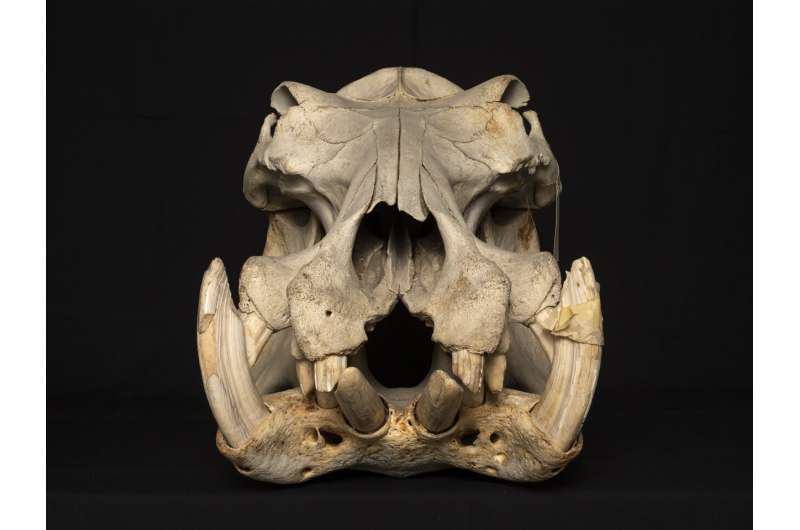This article has been reviewed according to Science X's editorial process and policies. Editors have highlighted the following attributes while ensuring the content's credibility:
fact-checked
peer-reviewed publication
trusted source
proofread
Hippos' prominent tusks and wide gaping mouths prevent efficient chewing, study shows

Hippos' huge tusks and wide gape restrict grinding jaw movements, making their chewing inefficient, according to a study by Annika Avedik and Marcus Clauss at the University of Zurich, Switzerland published in the open-access journal PLOS ONE.
Hippos have the widest gape of any mammal but are very inefficient at chewing, which limits how much they can eat. A possible explanation is that the size and arrangement of their teeth prevents them grinding their jaws side-to-side.
To investigate, researchers observed chewing in common hippos (Hippopotamus amphibius) and pygmy hippos (Choeropsis liberiensis) using video footage of zoo animals. They also measured the size and arrangement of teeth in the skulls of museum specimens from 86 common and 21 pygmy hippos, and looked for signs of wear that indicate how the animals chewed their food.
There was little difference for either species in the width of their upper and lower jaw or cheek teeth, suggesting a mainly vertical chewing motion. The size and positioning of their canine teeth don't prevent side-to-side chewing, but long lower canine teeth limit the extent of this grinding action.
Most importantly, common hippos have interlocking upper and lower front teeth which almost completely prevent side-to-side motion. Video footage and wear analysis confirmed that pygmy hippos use a slight side-to-side grinding motion when chewing, whereas common hippos rely almost exclusively on vertical jaw movements.
The slight side-to-side chewing movements used by living hippos suggest that the ancestors of both modern species relied more extensively on grinding jaw movements. Why modern hippos lost this ability remains unclear, but chewing efficiency may have been compromised in favor of evolving a rigid jaw and a wide gape, which is an asset during fights with other hippos. Inefficient chewing might have restricted common hippos to a semi-aquatic lifestyle, the authors say.
The authors add, "Most herbivores grind their food by moving the jaw sideways. Hippos have given up on this because they need a rigid jaw for fighting."
More information: Chewing, dentition and tooth wear in Hippopotamidae (Hippopotamus amphibius and Choeropsis liberiensis), PLOS ONE (2023). DOI: 10.1371/journal.pone.0291825. journals.plos.org/plosone/arti … journal.pone.0291825
Journal information: PLoS ONE
Provided by Public Library of Science


















